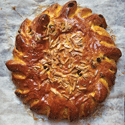
Saffron in Sweden: A Cherished Spice
Saffron imparts color and flavor to these Swedish holiday breads and cakes.
The reddish orange and famously expensive spice known as saffron—which consists of the painstakingly harvested stigmata of the Crocus sativus flower—imparts its golden hue and faintly spicy flavor to a number of feast breads and holiday cakes in Sweden. Saffron first arrived in Sweden via trade with Asia in the 1300s and was traditionally reserved for holiday baking because of its extravagance.
There are a number of ways bakers extract color and flavor from the spice. Many steep the delicate strands in warm milk before adding flour and eggs to make their dough. Others grind the spice with sugar crystals. Some mix saffron with a bit of sugar and vodka to create a distilled extract. Always, the trick is to use the precious spice sparingly.
Quite a few of the saffron-spiced sweets, like ulkaka med saffran, a raisin-studded Christmas cake, date back centuries, but there are also new saffron desserts, such as chocolate chip biscotti (saffranskorpor med choklad) that have become popular in recent years. Lussekatter is a mildly sweet saffron bread baked in a variety of shapes, including braided or spiral buns and a cake-like version called almogekaka. Saffron is commonly paired with almonds and dried fruit, as in the mandelkaka, a rich, buttery almond-saffron cake.
Keep Reading
Continue to Next Story










